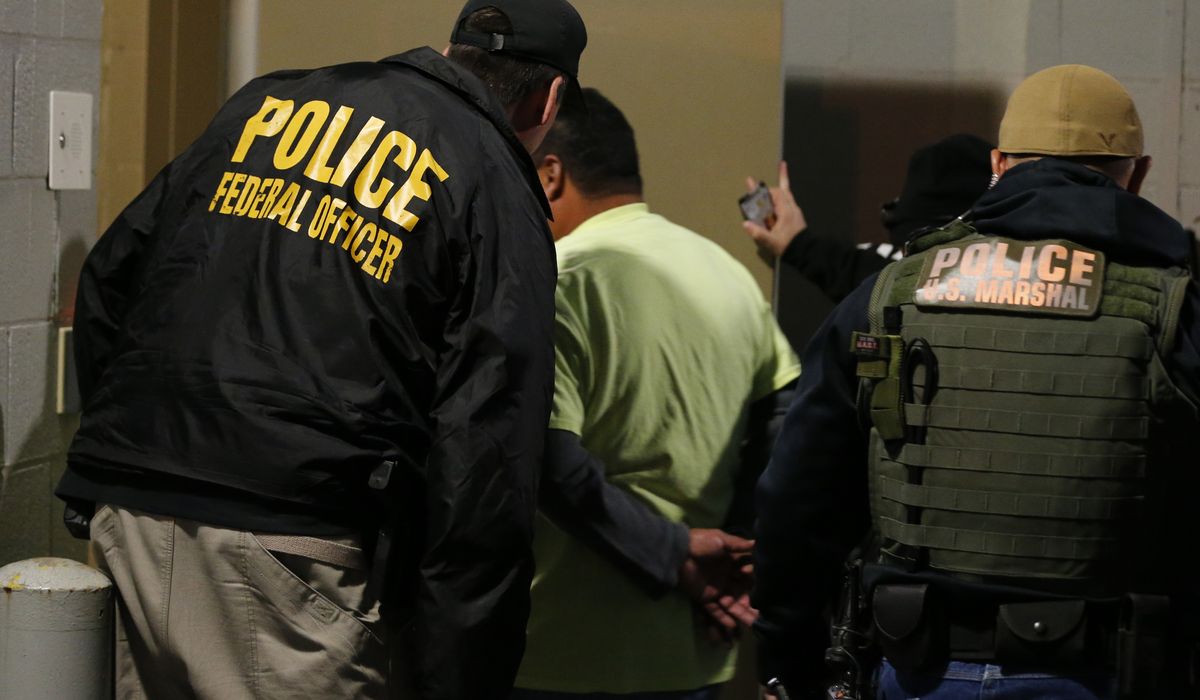
The Department of Homeland Security has expanded its list of locations off-limits for enforcement to include anywhere near graveyards, community organization offices and any area where children “gather” — effectively blocking officers from making arrests across many urban areas.
The rules, issued Wednesday, are designed to give illegal immigrants and others associated with them access to essential services without fear of arrest, said Homeland Security Secretary Alejandro Mayorkas.
“This principle is fundamental,” Mr. Mayorkas said in a memo. “We can accomplish our enforcement mission without denying or limiting individuals’ access to needed medical care, children access to their schools, the displaced access to food and shelter, people of faith access to their places of worship, and more.”
The rules bind U.S. Immigration and Customs Enforcement, which makes arrests in the interior of the country, and the Border Patrol, which works along the nation’s boundaries.
ICE has always had a “sensitive locations” policy that puts churches, hospitals and schools off-limits for arrests, but the latest policy turns them into “protected areas” and adds massive sanctuaries where immigration agents and enforcement officers are told to stay out.
Among the new locations are any place children “gather.” Examples are playgrounds, day care facilities and school bus stops. Any social services location is also on the no-go list.
Mr. Mayorkas said ICE employees nearby “can have the same restraining impact” on someone trying to access a service, so officers need to avoid areas around playgrounds and school bus stops, not just the specific locations.
He acknowledged there was no “bright-line definition” of what “near” means and said it will be an “exercise of judgment.”
“Our obligation to refrain, to the fullest extent possible, from conducting a law enforcement action in or near a protected area thus applies at all times and is not limited by hours or days of operation,” Mr. Mayorkas wrote.
Mr. Mayorkas said the rules don’t amount to an absolute ban, but barring the most severe cases, any agent or officer who wants to make an arrest, serve documents or conduct surveillance must get approval before entering the no-go zone.
Naureen Shah at the American Civil Liberties Union said the group fears the rule gives officers too much discretion.
“Time and again, we have seen individual ICE and CBP agents, motivated by animosity toward immigrants, distort and shirk intended reforms,” the ACLU lawyer said.
ICE employees said the rules leave few areas in cities that would not qualify as “near” one of the no-go locations, giving them little room to maneuver.
“It might have been easier for the Biden administration to list locations where immigration enforcement is actually allowed,” said Jon Feere, former chief of staff at ICE. “This is just the latest example of the Biden administration’s effort to dramatically curtail immigration enforcement by any means necessary.”
Immigrant rights advocates, on the other hand, have long demanded an expanded list of off-limits locations. They say the presence of ICE scares immigrants who are in the U.S. both legally and illegally.
Wendy Cervantes, director of immigration at the Center for Law and Social Policy, said she hears stories of immigration officers waiting for parents to drop off children at school, “sometimes forcing children to witness their parents’ arrest at the start of a school day.”
Her organization said the locations surrounding children are particularly important in addressing “the chilling effect” immigrant parents feel when taking their children to places.
Mr. Feere said the Biden administration already has severely narrowed the list of targets for ICE enforcement to national security threats and the most serious of criminals, as well as recent border crossers.
The criminal targets ICE is pursuing in communities have usually been released by a local jurisdiction under a sanctuary policy, and now officers will face an even tougher time trying to track them down said Mr. Feere, who is now director of investigations at the Center for Immigration Studies.
“I’m not sure they understand how law enforcement works, but prior to an arrest, officers have to make observations. They have to be near a location where they plan to make an arrest. This policy would seem to prohibit even basic surveillance,” he said.
Mr. Mayorkas’ policy is effective immediately.
He said his list of protected areas isn’t exclusive, but he gave an extensive list of examples that included schools, day care centers and colleges; COVID-19 vaccination centers; religious locations; social services locations, including those run by private groups; emergency relief locations; funerals; parades; and places where children gather.
For that latter category, he said, it at least includes “a playground, recreation center, child care center, before- or after-school care center, foster care facility, group home for children, or school bus stop.”
The Biden administration also has ruled courthouses and their surrounding areas off-limits.
ICE officers defended the use of courthouses, arguing they were known safe locations where people had already gone through security, so the danger of a violent encounter with an armed target was dramatically lower.








